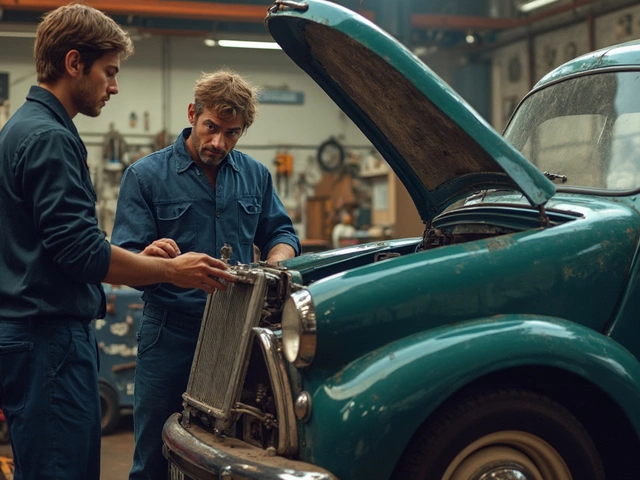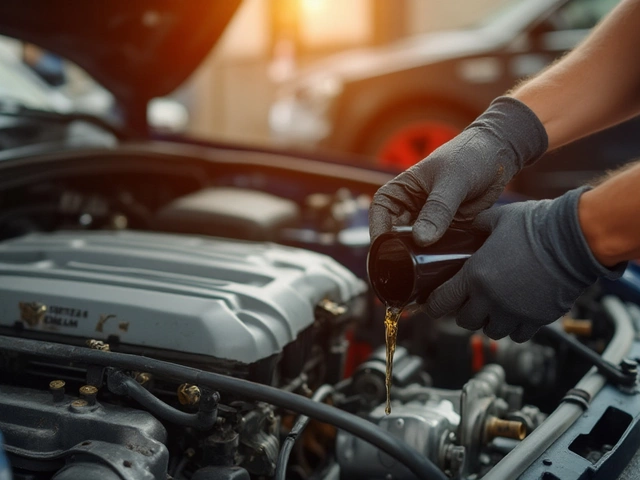If your steering wheel shakes every time you hit a bump, something’s up. Maybe you’re hearing clunks or strange squeaks from the front of your car. Or your tires look chewed up around the edges while your friend’s ride is smooth as butter. Front suspension trouble sneaks up on people way more than you’d think—loads of drivers just adjust to the noise or ignore the rough ride.
Here’s the deal: your front suspension is what keeps your car steady and predictable. When it’s shot, you’re risking way more than an irritating drive. You could screw up your tire life, struggle to stop quickly, or even mess up your car’s alignment so badly it wants to pull off the road. Don’t wait for a mechanic to tell you something’s wrong—most of the early warning signs are right in front of your face if you know what to look (and listen) for.
- Spotting the Warning Signs
- How Front Suspension Works (Without the Jargon)
- Common Causes Behind Suspension Trouble
- Simple Checks You Can Do Yourself
- When to Call in a Pro
- Mistakes to Avoid and Maintenance Tips
Spotting the Warning Signs
Catching front suspension problems early is all about noticing little changes before they become a big headache. You don’t have to be a car whiz to spot these. The most obvious clue is a bumpy or rough ride when you drive over cracks, potholes, or speed bumps. If your car used to glide and now things feel harsh, your suspension’s likely not doing its job.
Noises are another giveaway. If you hear clunking, knocking, or creaking from the front end, especially when turning or going over bumps, your suspension might be worn out. Loose or damaged parts like ball joints or control arms can lead to this racket.
Watch out for uneven tire wear. Suspensions that are shot can’t keep the wheels lined up right, so you’ll see one side of the tire wearing down a lot faster. Check your tires often—if they’re wearing funny, your suspension could be the culprit, not just your alignment.
- Front suspension noises: clunking, squeaking, or rattling
- Steering feels loose or wanders, especially on rough roads
- Car pulls to one side or sways a lot during turns
- Visible fluid leaking near the struts or shocks
- Nose-diving when braking or squatting in the rear when accelerating
Push down on your car’s hood and let go—if it bounces more than twice, those shocks or struts are tired. Don’t forget: small issues can quickly wreck other parts and hit your wallet harder if you ignore them. The sooner you notice weird sounds, uneven tires, or rough driving, the easier (and cheaper) it’ll be to fix.
How Front Suspension Works (Without the Jargon)
Your front suspension isn’t just there to make your drive more comfortable. Its main job is actually to keep your tires in solid contact with the road, no matter how bumpy things get. If it’s in good shape, handling, steering, and even braking all stay tight and predictable.
The front suspension is a system—a handful of parts working together, not just one. Here’s what’s usually in the mix:
- Front suspension arms (also called control arms or wishbones)
- Shock absorbers (sometimes called struts up front)
- Springs (coil springs are most common)
- Ball joints
- Bushings
- Steering knuckles
Control arms connect the wheels to your car's body. The ball joints let things move as the wheels go up and down. Springs soak up the roughness from potholes or bumps in the road. The shocks damper that bounce—so you don’t feel like you’re on a trampoline every time you hit a speed bump.
Most front suspensions fall into one of two types: MacPherson strut (found on most small and midsize cars) or double wishbone (typical for trucks, SUVs, and some sporty cars). Both do the same job, just with different layouts. MacPherson struts take up less space, which is why you find them up front in most sedans and hatchbacks these days.
| Part | Main Job |
|---|---|
| Shock Absorber/Strut | Controls bounce and improves grip |
| Spring | Supports car weight, absorbs big bumps |
| Control Arm | Keeps wheels aligned with car frame |
| Ball Joint | Helps wheel pivot as you steer |
| Bushing | Reduces noise/vibration between joints |
Why should you care? Well, when any of these parts wear out or snap, everything from braking to cornering can get sketchy fast. According to recent data from AAA, worn-out shocks or struts can add up to 20% to your stopping distance in a panic-brake. That’s a whole extra car length—or more—if you have to slam on the brakes at a red light. So, keeping your suspension solid isn’t just about comfort—it’s about safety, too.
Common Causes Behind Suspension Trouble
Most front suspension issues come down to a few main problems. First up: plain old wear and tear. Suspension parts like shocks, struts, and bushings don’t last forever. Most start to show real problems after about 50,000 to 100,000 miles, depending on how much rough driving they’ve handled.
Then you’ve got potholes, speed bumps, and bumpy roads. These aren’t just annoying—they beat up your suspension every single time you go over them. Even one nasty pothole can bend key parts or shove things out of alignment. Hitting curbs is another big one, especially in city driving. A sharp curb knock can wreck a control arm or bust a ball joint in seconds.
Rust and corrosion can sneak up on suspension metal, especially if you drive where roads get salted in the winter. Over time, that rust eats away at parts, making them weaker and more likely to snap. Also, overloaded trunks or carrying heavy stuff all the time strains the suspension and weighs down the front end more than it’s built for.
“If your suspension has seen a lot of hard miles or takes regular hits from rough roads, small problems can add up. What starts as a little ‘off’ feeling can turn into real trouble if it’s ignored.” — Car Talk, NPR
Just to spell it out, here’s a quick list of the top causes of front suspension trouble:
- Natural wear from age and mileage
- Potholes, rough roads, and curb hits
- Rust and exposure to road salt
- Carrying too much weight or towing more than your car can handle
- Skipping regular maintenance (like denying your alignment or ignoring weird noises)
Some numbers tell the story. A study by AAA found that pothole damage alone costs American drivers about $3 billion a year in repairs. That’s not pocket change, and suspension issues are a big chunk of that expense.
| Cause | How It Damages Suspension |
|---|---|
| Potholes & Rough Roads | Bends or breaks key parts like control arms and ball joints |
| Rust/Corrosion | Weakens metal, risking sudden failure |
| Overloading | Makes parts wear out much faster |
| Skipped Maintenance | Allows small issues to become big repairs |
If you notice your car sitting lopsided, bouncing too much, or steering weird after hitting a pothole, don’t brush it off. That’s your front suspension screaming for attention.

Simple Checks You Can Do Yourself
If you think your front suspension might be trouble, you don’t have to wait for a mechanic to get a few answers. There are some quick checks you can pull off in your driveway or parking lot, no special tools needed.
- Bounce Test: Push down hard on the front corner of your car—let go, and see what happens. If your car bounces more than once or twice before stopping, your shocks or struts are probably worn out.
- Check Tire Wear: Grab a flashlight and take a good look at your front tires. Uneven wear (like bald edges or funky patterns) is a big red flag for suspension problems or alignment issues.
- Listen for Weird Noises: Take your car on a bumpy road or into a parking lot with speed bumps. Listen for clunks, knocks, or squeaks from the front end. Consistent sounds when you turn the wheel or go over bumps usually mean parts are loose or worn.
- Look for Leaks: Peek underneath at the shocks or struts. If you spot oil or greasy fluid on them, they're probably leaking and need to be swapped out.
- Steering Check: When the car is parked, turn the steering wheel a little side to side. If you feel play or hear clunks, something in the suspension or steering may be worn.
Here's a quick table to help you read those signs:
| DIY Check | What to Watch For | Likely Problem |
|---|---|---|
| Bounce test | Car bounces 2+ times | Worn shocks/struts |
| Tire inspection | Bald spots or uneven wear | Bad alignment, bad suspension |
| Sound check | Clunks, squeaks, rattles | Loose/worn parts |
| Leak look | Oil on struts/shocks | Leaking shocks/struts |
| Steering wiggle | Loose or odd feel, noises | Tired steering or suspension |
These checks won’t cost you a dime and can catch major problems before you get stuck with a bigger bill. If a couple of these signs show up, it’s worth making an appointment with your local shop before things get worse.
When to Call in a Pro
Sometimes, you just hit a wall with DIY checks. If you’ve got a loud clunk up front, a steering wheel that feels loose, or the car dips super hard to one side, that’s your cue. These aren’t just little quirks—they’re big red flags for front suspension issues that can spiral fast. If your car pulls to one side on a straight road, you need expert help. Noises that get louder over time or get worse when you turn usually mean it’s time to make an appointment.
Replacing ball joints, tie rods, struts, or control arms is not beginner territory. These parts keep your wheels connected and lined up. Messing them up can make things way worse or even dangerous. If you spot any leaking fluid around the shocks or struts, don’t wait. That’s a sign they’ve failed, and, for most people, a quick fix in the driveway just isn’t realistic.
You might think skipping the shop saves you cash, but here’s what really happens: If your suspension is toast, tires can wear out in months (not years). Bad alignment also drags down your gas mileage. Experts say cars should have their suspension checked at least once a year—more if you drive on rough roads or haul heavy loads.
| Symptom | What It Could Mean | DIY or Pro? |
|---|---|---|
| Clunking/knocking sound | Failed ball joint, bushing, or tie rod | Pro |
| Leaking strut or shock | Blown shock absorber/strut | Pro |
| Uneven tire wear | Alignment issue or worn suspension | Pro |
| Steering pulls to one side | Severe alignment or suspension problem | Pro |
| Ride feels bouncy or floats | Worn shocks or struts | Usually Pro |
If you don’t have a jack, stands, and the right tools—or if you feel even a little nervous about tackling suspension work—just don’t risk it. Good mechanics can check for hidden damage with specialized tools (think spring compressors and alignment racks). That’s not something you want to guess at in the driveway. And if your car has advanced tech, like adaptive suspensions or electronic controls, it’s definitely a job for a pro. Trust me, calling a shop early usually saves money and stress down the road.
Mistakes to Avoid and Maintenance Tips
It’s way too easy to brush off those small clunks or squeaky noises, but ignoring suspension problems can cost you a whole lot more in the long run. One huge mistake people make is just swapping out one part, like a single shock absorber, and leaving everything else old and worn out. Suspensions are a team effort—when one part’s toast, the rest aren’t far behind. That’s why pros always recommend checking everything at once instead of playing whack-a-mole with random fixes.
Another trap is skipping out on regular alignments, especially after hitting potholes or curbs. Even something as minor as a bad bump can knock your front wheels out of whack, which then eats up your tires and wrecks your smooth ride. Did you know research by the Car Care Council found that roughly 1 in 10 cars on the road have at least one seriously worn suspension part?
Want better handling and a safer car? Here are some straightforward ways to keep your front suspension in good shape:
- Get your suspension inspected every 12,000 miles or once a year—whichever comes first.
- Don't ignore uneven tire wear. It’s almost always a sign your front suspension needs attention.
- Replace parts in pairs (both left and right sides)—that way, your car handles evenly.
- After replacing any major suspension part, always get a wheel alignment.
- Wash out road salt and dirt from your wheel wells if you live somewhere with winter. Salt corrodes suspension parts.
Here’s a quick table showing how long common suspension parts usually last—though your mileage may vary, literally:
| Suspension Part | Average Lifespan (Miles) |
|---|---|
| Shock Absorbers/Struts | 50,000 to 100,000 |
| Ball Joints | 70,000 to 150,000 |
| Bushings | 45,000 to 100,000 |
| Control Arms | 80,000 to 150,000 |
If you spot grease leaks or torn rubber boots on suspension parts, don’t wait. Even a small leak means dirt can creep in and do some real damage. So, yes—regular checks beat surprise repairs every time.




